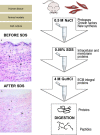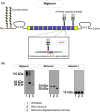Vascular proteomics in metabolic and cardiovascular diseases
- PMID: 26940365
- PMCID: PMC5042041
- DOI: 10.1111/joim.12486
Vascular proteomics in metabolic and cardiovascular diseases
Abstract
The vasculature is essential for proper organ function. Many pathologies are directly and indirectly related to vascular dysfunction, which causes significant morbidity and mortality. A common pathophysiological feature of diseased vessels is extracellular matrix (ECM) remodelling. Analysing the protein composition of the ECM by conventional antibody-based techniques is challenging; alternative splicing or post-translational modifications, such as glycosylation, can mask epitopes required for antibody recognition. By contrast, proteomic analysis by mass spectrometry enables the study of proteins without the constraints of antibodies. Recent advances in proteomic techniques make it feasible to characterize the composition of the vascular ECM and its remodelling in disease. These developments may lead to the discovery of novel prognostic and diagnostic markers. Thus, proteomics holds potential for identifying ECM signatures to monitor vascular disease processes. Furthermore, a better understanding of the ECM remodelling processes in the vasculature might make ECM-associated proteins more attractive targets for drug discovery efforts. In this review, we will summarize the role of the ECM in the vasculature. Then, we will describe the challenges associated with studying the intricate network of ECM proteins and the current proteomic strategies to analyse the vascular ECM in metabolic and cardiovascular diseases.
Keywords: apolipoproteins; atherosclerosis; diabetes; proteomics; restenosis; vascular biology.
© 2016 The Authors. Journal of Internal Medicine published by John Wiley & Sons Ltd on behalf of Association for Publication of The Journal of Internal Medicine.
Figures



Similar articles
-
Systems biology-opportunities and challenges: the application of proteomics to study the cardiovascular extracellular matrix.Cardiovasc Res. 2016 Dec;112(3):626-636. doi: 10.1093/cvr/cvw206. Epub 2016 Sep 15. Cardiovasc Res. 2016. PMID: 27635058 Free PMC article. Review.
-
Ten Years of Extracellular Matrix Proteomics: Accomplishments, Challenges, and Future Perspectives.Mol Cell Proteomics. 2023 Apr;22(4):100528. doi: 10.1016/j.mcpro.2023.100528. Epub 2023 Mar 12. Mol Cell Proteomics. 2023. PMID: 36918099 Free PMC article. Review.
-
Defining the extracellular matrix using proteomics.Int J Exp Pathol. 2013 Apr;94(2):75-92. doi: 10.1111/iep.12011. Epub 2013 Feb 19. Int J Exp Pathol. 2013. PMID: 23419153 Free PMC article. Review.
-
Exploring the extracellular matrix in health and disease using proteomics.Essays Biochem. 2019 Sep 13;63(3):417-432. doi: 10.1042/EBC20190001. Print 2019 Sep 13. Essays Biochem. 2019. PMID: 31462529 Review.
-
Glycoproteomics of the Extracellular Matrix: A Method for Intact Glycopeptide Analysis Using Mass Spectrometry.J Vis Exp. 2017 Apr 21;(122):55674. doi: 10.3791/55674. J Vis Exp. 2017. PMID: 28518125 Free PMC article.
Cited by
-
Chemoselective Characterization of New Extracellular Matrix Deposition in Bioengineered Tumor Tissues.bioRxiv [Preprint]. 2025 Mar 19:2025.03.18.643336. doi: 10.1101/2025.03.18.643336. bioRxiv. 2025. PMID: 40166338 Free PMC article. Preprint.
-
Glycoproteomic Analysis of the Aortic Extracellular Matrix in Marfan Patients.Arterioscler Thromb Vasc Biol. 2019 Sep;39(9):1859-1873. doi: 10.1161/ATVBAHA.118.312175. Epub 2019 Jul 18. Arterioscler Thromb Vasc Biol. 2019. PMID: 31315432 Free PMC article.
-
Vulnerable Atherosclerotic Plaque: Is There a Molecular Signature?Int J Mol Sci. 2022 Nov 7;23(21):13638. doi: 10.3390/ijms232113638. Int J Mol Sci. 2022. PMID: 36362423 Free PMC article. Review.
-
Cardiovascular biomarkers in body fluids: progress and prospects in optical sensors.Biophys Rev. 2022 Aug 18;14(4):1023-1050. doi: 10.1007/s12551-022-00990-2. eCollection 2022 Aug. Biophys Rev. 2022. PMID: 35996626 Free PMC article. Review.
-
Compartment-resolved Proteomic Analysis of Mouse Aorta during Atherosclerotic Plaque Formation Reveals Osteoclast-specific Protein Expression.Mol Cell Proteomics. 2018 Feb;17(2):321-334. doi: 10.1074/mcp.RA117.000315. Epub 2017 Dec 4. Mol Cell Proteomics. 2018. PMID: 29208753 Free PMC article.
References
-
- Didangelos A, Simper D, Monaco C, Mayr M. Proteomics of acute coronary syndromes. Curr Atheroscler Rep 2009; 11: 188–95. - PubMed
-
- Hynes RO, Naba A. Overview of the matrisome – an inventory of extracellular matrix constituents and functions. Cold Spring Harb Perspect Biol 2012; 4: a004903. doi: 10.1101/cshperspect.a004903. - DOI - PMC - PubMed
-
- Dietz HC, Cutting GR, Pyeritz RE et al Marfan syndrome caused by a recurrent de novo missense mutation in the fibrillin gene. Nature 1991; 352: 337–9. - PubMed
Publication types
MeSH terms
Substances
Grants and funding
LinkOut - more resources
Full Text Sources
Other Literature Sources
Medical

